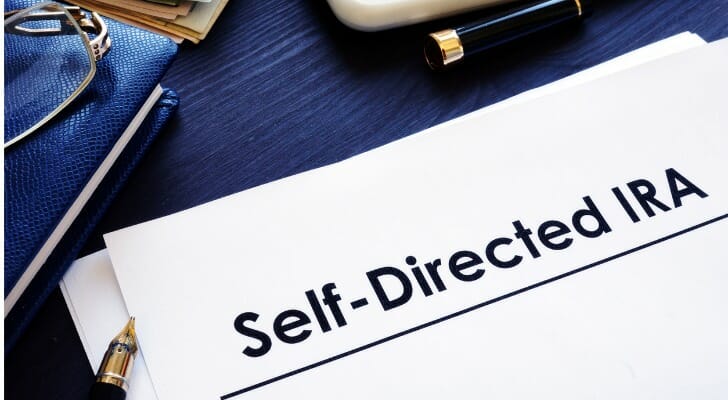While most individual retirement plans focus on stocks and bonds, self-directed IRAs can allow you to invest in a broader range of assets, from petting zoos and laser tag arenas to residential real estate and silver bars. This account type helps you to diversify your portfolio in unconventional ways and earn hefty returns. Here’s how to open and set up a self-directed IRA.
From 401(k)s to IRAs, a financial advisor can help you manage your retirement savings.
What Is a Self-Directed IRA?
A self-directed IRA allows you to invest in various assets that typical IRAs can’t access. For example, regular IRAs usually invest in mutual funds, exchange-traded funds (ETFs), stocks, and bonds. However, beyond these traditional asset types, self-directed IRAs can also hold real estate, privately held businesses, tax liens, livestock and more. As a result, you can enjoy the tax benefits of an IRA while investing in alternative assets.
Self-directed IRAs share many characteristics with the average IRA. For example, you can get one in the Roth or traditional variety to suit your tax preferences. In addition, you have the same annual contribution limit: $7,000 for 2024 and 2025 or $8,000 if you’re 50 or older. Lastly, you’ll incur penalties in most situations if you withdraw money before age 59 ½.
Steps to Opening a Self-Directed IRA
A self-directed IRA is more complex than a regular IRA. Therefore, opening one requires more legwork. The following steps are necessary to obtain a self-directed IRA:
Step 1: Find a Custodial Firm
Opening a typical IRA is as simple as asking your bank or using a major investment company to open an account. However, you can only find self-directed IRAs at smaller investment firms specializing in non-traditional accounts. So, you’ll have to find one by searching the internet, asking your network for recommendations or consulting a financial advisor. It’s best to shop around and pick one you trust with your retirement savings. However, the law prohibits your custodian from providing financial advice.
Step 2: Perform Due Diligence
While a traditional IRA allows you to invest in an index fund without needing active management, a self-directed IRA requires a hands-on approach. In other words, putting a winery in your IRA doesn’t mean you’ll automatically make money. Instead, you’ll need to plan your investment strategy. Doing so means understanding your asset appreciation, the associated fees, the tax implications and how you’ll cash out.
Step 3: Choose Your Investments
Once you create an investment plan, you can direct your custodian to place specific assets into your account. For example, you might choose to invest a substantial amount in gold or a parcel of undeveloped land.
6 Investment Options for a Self-Directed IRA
A self-directed IRA has wide-ranging possibilities for investing. Here are some of the most common types of unconventional investments that you could consider:
1. Precious Metals
Silver, gold, platinum, and other metals can help you diversify your portfolio. They usually hold their value during market downturns and don’t depreciate because of inflation. However, tax laws prohibit self-directed IRAs from holding collectibles, a classification the IRS applies to certain metal investments. Therefore, it’s vital to understand what type of asset your precious metal stash is.
2. Real Estate
A self-directed IRA is a catch-all for real estate investments. Whether you own acres of cornfields or a Caribbean beach house, you can put it into your self-directed IRA. In addition, you can also invest in real estate investment trusts (REITs) and mortgage notes.
Another way to indirectly invest in real estate is to purchase tax lien certificates. When a property owner defaults on their mortgage, the municipality can sell the tax lien. Investors can purchase the liens sold at auction.
3. Non-Traded Businesses
Not all companies sell their shares in the public stock market. Fortunately, your self-directed IRA allows investments in private companies, such as LLCs, C corporations, limited partnerships, hedge funds, private placements, and startups.
4. Energy Holdings
Energy investments are also viable assets for self-directed IRAs. For example, mineral rights, oil, gas, water power and solar energy assets can all be held in a self-directed IRA.
5. Private Lending
Private debt can provide substantial investment income. Specifically, you can invest in personal, auto and business loans. In addition, mortgage holdings can go in a self-directed IRA.
6. Self-Owned LLCs
You can also create an LLC for your self-directed IRA to manage. An investment LLC can increase efficiency and reduce costs for the same assets you’d invest in otherwise.
Advantages of a Self-Directed IRA
Self-directed IRAs offer remarkable flexibility that traditional retirement accounts simply can’t match. While conventional IRAs typically limit you to stocks, bonds, and mutual funds, self-directed IRAs open doors to alternative investments like real estate, precious metals, private equity, and even cryptocurrency. This expanded universe of investment options allows investors to leverage specialized knowledge or take advantage of opportunities in markets they understand well.
True portfolio diversification extends beyond simply owning different stocks or bonds. Self-directed IRAs enable investors to spread risk across entirely different asset classes that may respond differently to market conditions. This diversification can provide a buffer against stock market volatility, potentially creating more stability in your retirement portfolio during economic downturns when traditional investments might simultaneously decline.
One of the most compelling advantages of a self-directed IRA is the potential for higher returns through alternative investments. Real estate holdings, private business investments, and other non-traditional assets can sometimes outperform standard market offerings. Investors with expertise in specific sectors can capitalize on their knowledge to potentially achieve greater growth than what might be possible through conventional investment vehicles alone.
Self-directed IRAs maintain all the tax benefits of traditional retirement accounts while offering expanded investment options. Whether structured as a traditional IRA with tax-deferred growth or as a Roth IRA with tax-free withdrawals in retirement, these advantages apply to your alternative investments as well. Real estate rental income, appreciation on precious metals or profits from private equity deals all grow within the tax-advantaged environment of your retirement account.
Risks of a Self-Directed IRA
Self-directed IRAs offer investors greater control over their retirement assets, allowing them to venture beyond traditional stocks and bonds into alternative investments like real estate, private equity, and precious metals. While this flexibility can be appealing, it’s important to understand the potential pitfalls before diving in. Self-directed IRAs come with unique challenges that traditional retirement accounts don’t present. Here are some of the most important cons to consider:
- Asset Performance: Non-traditional assets don’t have guaranteed returns. So, your cattle ranch might become a financial disaster, causing you to lose tens or hundreds of thousands of dollars. It’s up to you to assess an asset’s risk, fees and potential returns – not your custodian. Therefore, you’ll have to depend on your own discernment and investing approach to identify profitable investments.
- Prohibited Transactions: The IRS has specific rules for self-directed IRAs. If you break regulations for prohibited transactions, you’ll likely jeopardize the account’s tax advantages and incur financial penalties. For example, you can’t lend yourself money from your IRA or furnish an investment property using money from your account. As a result, it’s crucial to understand the boundaries for managing your IRA.
- Liquidity Problems: Assets in typical IRAs are highly liquid because you can quickly turn ETFs and mutual funds into cash. On the other hand, you might have trouble finding a buyer for stock in a privately held company, and the stock might be difficult to value. This situation can result in the inability to turn assets into cash when you need it. You could even incur financial penalties if liquidity issues arise when you try to take required minimum distributions (RMDs).
- Management Issues: The companies that run self-directed IRAs are less accountable to their customers than typical investment firms since they’re not treated as fiduciaries. This drawback means they might overestimate asset performance. In addition, if you go in on an investment with others, disagreements on strategy can stall returns without offering a clear way out.
- Asset Concentration: While diversification means spreading your money and risk across numerous asset types, concentration means putting all your eggs in one basket. Concentration can occur in self-directed IRAs when you get in too deep with one or two investments and ignore other opportunities. It’s key to balance risky, unconventional ventures with stable investments, such as index funds. Otherwise, you could lose your nest egg if an asset tanks.
While self-directed IRAs offer expanded investment opportunities, they come with substantial risks that require careful consideration. The increased responsibility, potential for prohibited transactions, and vulnerability to fraud make these accounts suitable primarily for financially sophisticated investors. Before establishing a self-directed IRA, consider consulting with a financial advisor who can help you weigh these risks against your retirement goals and investment expertise.
Bottom Line
A self-directed IRA gives you the flexibility to invest in unique assets. Your real estate, small business ventures, precious metals and more can go into a self-directed IRA, generating value and providing tax advantages. However, the variety of asset types means managing the account is more involved, and hiring a custodian is required. In addition, because third-party administration of non-traditional investments introduces more risk, it’s crucial to do your homework and diversify your portfolio.
Tips for Opening a Self-Directed IRA
- A self-directed IRA needs a thorough plan and a trustworthy custodian. Fortunately, a financial advisor can help identify worthwhile assets and appoint a reliable trustee for your account. Finding a financial advisor doesn’t have to be hard. SmartAsset’s free tool matches you with vetted financial advisors who serve your area, and you can have a free introductory call with your advisor matches to decide which one you feel is right for you. If you’re ready to find an advisor who can help you achieve your financial goals, get started now.
- A custodian is a non-optional entity involved in self-directed IRAs. Because you need one, it’s essential to understand how to find the best custodian for your account.
Photo credit: ©iStock.com/designer491, ©iStock.com/thad, ©iStock.com/insta_photos


